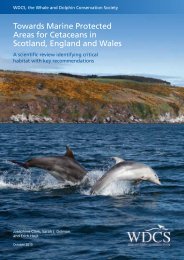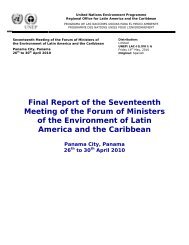Sea Turtle Recovery Action Plan for Barbados - WIDECAST
Sea Turtle Recovery Action Plan for Barbados - WIDECAST
Sea Turtle Recovery Action Plan for Barbados - WIDECAST
You also want an ePaper? Increase the reach of your titles
YUMPU automatically turns print PDFs into web optimized ePapers that Google loves.
CEP Technical Report No. 12<br />
4.32 Regional cooperation<br />
It is likely that hawksbill turtles move freely among the islands of the Lesser Antilles (as<br />
is known to occur in other sea turtle species), and collaborative conservation ef<strong>for</strong>ts by several<br />
different countries will be required to safeguard depleted populations. This may prove to be<br />
difficult since some other countries, such as St. Vincent and the Grenadines, rely relatively<br />
heavily on sea turtle exploitation. Nonetheless, the cooperation of neighbouring states is important<br />
to the success of any sea turtle protection measures instituted in <strong>Barbados</strong>. One mechanism<br />
<strong>for</strong> co-operation on a regional scale is the Convention <strong>for</strong> the Protection and Development of the<br />
Marine Environment of the Wider Caribbean Region (the "Cartagena Convention"). The<br />
Cartagena Convention is coupled with an <strong>Action</strong> <strong>Plan</strong>, known as the <strong>Action</strong> <strong>Plan</strong> <strong>for</strong> the Caribbean<br />
Environment Programme (APCEP). The First Intergovernmental Meeting on APCEP was<br />
convened by UNEP in cooperation with the Economic Commission <strong>for</strong> Latin America in Montego<br />
Bay, Jamaica, in 1981. The representatives of Governments from 22 States in the region,<br />
including <strong>Barbados</strong>, adopted APCEP at this meeting and established the Caribbean Trust Fund to<br />
support common costs and activities associated with the implementation of the <strong>Action</strong> <strong>Plan</strong>.<br />
In March, 1983, a Conference of Plenipotentiaries met in Cartagena, Colombia, to<br />
negotiate what would become known as the Cartagena Convention. Representatives from 16<br />
States participated. The Conference adopted both the Convention and a Protocol concerning cooperation<br />
in combating oil spills in the region. The Convention describes the responsibilities of<br />
Contracting Parties to "prevent, reduce and control" pollution from a variety of sources (i.e., atsea<br />
dumping of waste, pollution from ships, land-based and airborne sources, and from sea-bed<br />
activities). Article 10 is of special interest to sea turtles in that it addresses the responsibilities of<br />
Contracting Parties to "individually or jointly, take all appropriate measures to protect and<br />
preserve rare or fragile ecosystems, as well as the habitat of depleted, threatened or endangered<br />
species, in the Convention area." <strong>Barbados</strong> ratified the Cartagena Convention on 28 May 1985.<br />
In January 1990, a Protocol Concerning Specially Protected Areas and Wildlife (SPAW)<br />
to the Cartagena Convention was adopted by a Conference of Plenipotentiaries, providing a<br />
mechanism whereby species of wild fauna and flora could be protected on a regional scale. The<br />
landmark Protocol grants explicit protection to species listed in three categories, or annexes.<br />
Annex I includes species of flora exempt from all <strong>for</strong>ms of destruction or disturbance. Annex II<br />
ensures total protection and recovery to listed species of fauna, with minor exceptions.<br />
Specifically, Annex II listing prohibits (a) the taking, possession or killing (including, to the<br />
extent possible, the incidental taking, possession or killing) or commercial trade in such species,<br />
their eggs, parts or products, and (b) to the extent possible, the disturbance of such species,<br />
particularly during periods of breeding, incubation, estivation or migration, as well as other<br />
periods of biological stress. Annex III denotes species in need of "protection and recovery", but<br />
subject to a regulated harvest.<br />
On 11 June 1991, Plenipotentiaries again met in Kingston, Jamaica, to <strong>for</strong>mally adopt the<br />
Annexes. The Conference voted unanimously to include all six species of sea turtle inhabiting<br />
the Wider Caribbean (these are: Caretta caretta, Chelonia mydas, Eretmochelys imbricata,<br />
Dermochelys coriacea, Lepidochelys kempii, L. olivacea) in Annex II (UNEP, 1991; Eckert,<br />
1991). The unanimous vote on this issue is a clear statement on the part of Caribbean govern-<br />
Page 30

















